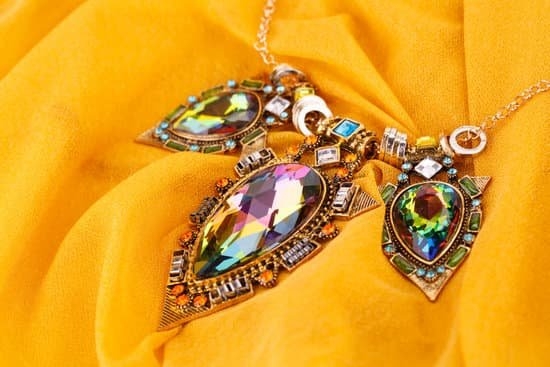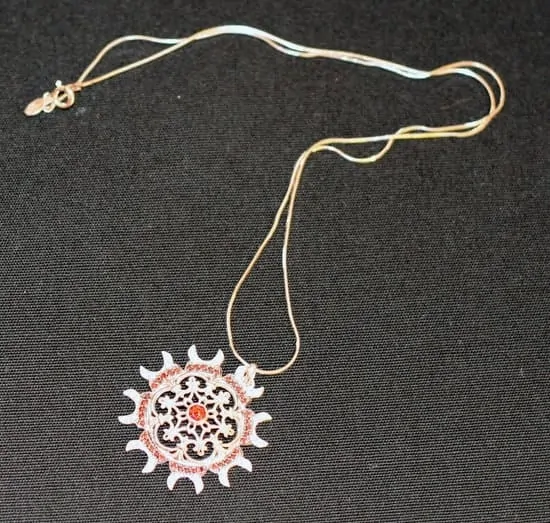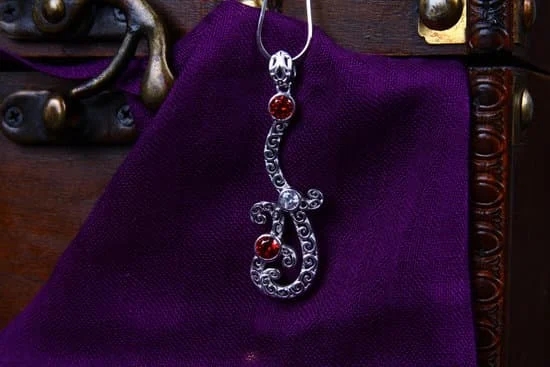Crystals have captivated humans for centuries with their incredible beauty and mystical properties. In recent years, they have surged in popularity as an enchanting choice for jewelry. Whether you are drawn to the sparkling facets or are seeking the unique metaphysical properties that different crystals possess, setting crystals in jewelry can be a rewarding and creative venture.
One of the reasons crystals have become increasingly popular in jewelry is because they offer more than just aesthetic appeal. Many people believe that each crystal carries its own energy and metaphysical properties, which can bring balance, healing, and positive vibrations into our lives. From the soothing energies of amethyst to the grounding properties of black tourmaline, there is a crystal suitable for every intention and desire.
When it comes to selecting crystals for jewelry making, it’s important to consider their unique qualities and benefits. Some crystals may promote emotional healing, while others encourage clarity of thought or enhance spiritual connection. By understanding these properties, we can choose specific crystals that align with our intentions and create powerful pieces of wearable art.
As you embark on your journey of setting crystals in jewelry, it’s essential to gather all the necessary tools and materials. This includes items like wire, chains, findings, settings, and various other components depending on your chosen technique.
Quality materials are crucial for producing durable and stunning jewelry pieces that will stand the test of time. So let’s dive into the world of crystal jewelry making and discover how to set these precious stones so they can shine brightly in your creations.
Types of Crystals Ideal for Jewelry Making
Crystals are a popular choice for jewelry making due to their natural beauty and unique metaphysical properties. There are various types of crystals that are ideal for creating stunning and meaningful jewelry pieces. Here are some of the commonly used crystals in jewelry making, along with their specific qualities and benefits:
- Amethyst: Known as the stone of spirituality and intuition, amethyst is prized for its calming energy and ability to enhance spiritual growth.
- Rose Quartz: This pink crystal is often associated with love, compassion, and emotional healing. It promotes self-love and attracts positive relationships.
- Clear Quartz: Clear quartz is known as the “master healer” due to its ability to amplify energy and purify negative energies. It is also highly versatile and can be paired with any other crystal.
- Citrine: Often called the “sunshine stone,” citrine brings joy, abundance, and success. It is believed to attract wealth and prosperity while bringing warmth and positivity into one’s life.
- Lapis Lazuli: A deep blue stone symbolizing wisdom and truth, lapis lazuli enhances intellectual abilities, intuition, and spiritual insight. It is highly sought after for its striking color.
When choosing crystals for jewelry making, there are some considerations to keep in mind. First, consider the intended purpose or meaning behind the piece of jewelry – whether it’s meant for healing, protection, or enhancing certain aspects of life. Additionally, take into account the color and aesthetics you desire for your jewelry design.
It’s worth noting that different crystals may have varying hardness levels, which can impact their durability in jewelry settings. Some fragile crystals may require more protective settings or be better suited for occasional wear rather than everyday use. Ultimately, finding the right type of crystal to incorporate into your jewelry designs will depend on personal preference and desired outcome.
Necessary Tools and Materials for Setting Crystals
When it comes to setting crystals in jewelry, having the right tools and materials is essential. Here is a list of necessary items that will help you get started:
- Pliers: A good set of pliers is crucial for jewelry making. Two types of pliers that are commonly used for crystal setting are chain nose pliers and round nose pliers. Chain nose pliers are great for gripping and bending wire, while round nose pliers are useful for creating loops and curves.
- Wire cutters: Wire cutters are necessary for cutting and trimming the wire used in crystal jewelry making. It’s important to have a pair of wire cutters specifically designed for jewelry making to ensure clean cuts without damaging the wire.
- Beading mat or tray: Working with small crystals and beads can be tricky, as they can easily roll away or get lost. Using a beading mat or tray provides a stable surface where you can organize your materials and prevents them from rolling off your workspace.
- Jewelry findings: Findings such as jump rings, ear wires, clasps, and bails are essential for connecting different components together in jewelry making. Make sure to have a variety of findings on hand so that you can choose the appropriate ones based on your design.
Now let’s talk about the materials needed for setting crystals in jewelry:
- Wire: Different gauges and types of wire can be used for setting crystals. The gauge refers to the thickness of the wire, with smaller numbers indicating thicker wire. Copper, sterling silver, and gold-filled wires are popular choices due to their malleability and durability.
- Chains: If you plan on creating necklaces or bracelets with crystal pendants or charms, it’s important to have quality chains available in various lengths and styles. Sterling silver or gold-filled chains work well with crystal jewelry designs.
- Settings: Depending on the type of crystal you’re working with, you may need settings to securely hold the crystals in place. Settings can be made of metal or non-metal materials like resin or clay. It’s important to choose settings that are the appropriate size and shape for your crystals.
Where can you find these tools and materials? Here are a few options:
- Local craft stores: Many craft stores carry basic jewelry making supplies, including pliers, wire cutters, findings, chains, and even some crystal beads and settings.
- Online retailers: There are numerous online retailers specializing in jewelry making supplies. Websites like Etsy, Rio Grande, and Fire Mountain Gems offer a wide range of tools, materials, and findings for crystal jewelry making.
- Gem and mineral shows: These shows often attract vendors selling a variety of crystals, as well as jewelry making tools and materials. It can be a great opportunity to find unique crystals and source high-quality materials.
By having the necessary tools and materials on hand, you’ll be well-prepared to embark on your crystal jewelry-making journey.
Preparing Crystals for Jewelry Setting
Crystals are not just beautiful adornments for jewelry; they also possess powerful metaphysical properties that can benefit the wearer. However, before setting crystals in jewelry, it is important to prepare them properly to maximize their energy and beauty. This section will provide step-by-step instructions on how to clean and clear crystals, as well as methods to charge and activate their energy.
Cleaning Crystals
Before setting crystals in jewelry, it is crucial to cleanse them of any negative or stagnant energies they may have picked up. There are several methods you can use to clean your crystals:
- Water Cleansing: Some crystals can be safely washed under running water, while others may dissolve or get damaged in water. Research the specific crystal you are working with to determine if water cleansing is appropriate.
- Smudging: Burn sage or palo santo and pass the crystals through the smoke. This method is especially useful for clearing away negative energies.
- Burial: Bury your crystals in the earth, preferably overnight or for a few days, to allow the earth’s natural energies to cleanse and recharge them.
Charging Crystals
Once your crystals have been cleansed, it’s time to charge them with energy. Charging infuses the crystals with positive vibrations and enhances their metaphysical properties. Here are some methods you can use to charge your crystals:
- Sunlight: Place your crystals outdoors in direct sunlight for a few hours or longer, depending on their specific needs. Be cautious as some stones may fade if exposed to intense sunlight for extended periods.
- Moonlight: Leave your crystals outside overnight during a full moon or place them near a windowsill where they can absorb moonlight.
- Selenite Charging Plate: Selenite is known for its purifying properties and can be used as a charging plate for other crystals. Simply place your crystals on a selenite plate or next to them overnight.
Enhancing the Beauty of Crystals
Before setting your crystals in jewelry, consider enhancing their natural beauty. One way to do this is by polishing and buffing the crystals to a high shine using a soft cloth or polishing pad. This will make your crystals sparkle and catch the light, adding visual appeal to your jewelry pieces.
You can also enhance the color and appearance of certain crystals by placing them near other stones with complementary energies. For example, you can pair a clear quartz crystal with an amethyst to enhance its spiritual properties.
Different Techniques for Setting Crystals
Crystals are not only beautiful to look at, but they also carry unique metaphysical properties that make them a popular choice for jewelry. In this section, we will explore different techniques for setting crystals in jewelry to help you create stunning and meaningful pieces. The three main techniques we will discuss are wire wrapping, bezel setting, and glue-on settings.
Wire wrapping is a versatile technique that allows you to securely hold crystals in place using wire. To begin, you will need the right wire gauge and type based on your desired design and the size of the crystal. Thin-gauge wires are ideal for delicate designs, while thicker gauges provide stability for larger crystals. Different wire materials such as copper, silver, or gold can add an aesthetic appeal to your jewelry.
Bezel setting involves creating a metal frame or collar around the crystal to securely hold it in place. There are different types of bezel settings like full bezel, partial bezel, or prong settings that offer varying levels of visibility for the crystal. You will need basic jewelry-making tools like pliers, cutters, and a jeweler’s saw to create custom bezels that fit the shape and size of your crystals.
Glue-on settings provide a simple method for setting crystals without using any metal components. These adhesive-based settings can be made from materials like resin or plastic. It is crucial to choose an appropriate adhesive that is compatible with both the crystal and setting material to ensure a secure bond.
| Technique | Description |
|---|---|
| Wire Wrapping | Using wire to wrap and secure crystals |
| Bezel Setting | Crafting metal frames to enclose and hold crystals |
| Glue-On Settings | Using adhesive-based settings to attach crystals |
By learning these different techniques, you can elevate your jewelry-making skills and create unique pieces that perfectly showcase the beauty and energy of crystals. Experiment with different combinations of techniques and crystal types to unlock your creativity and energize your style.
Step-by-Step Guide to Wire Wrapping Crystals
Choosing the Right Wire
When it comes to wire wrapping crystals, selecting the appropriate wire is crucial. The gauge and type of wire can greatly impact the overall look and durability of your jewelry piece. For beginners, it is recommended to start with softer wires such as copper or sterling silver, as they are more malleable and easier to work with.
As you gain experience, you can experiment with stiffer wires like brass or gold-filled for a different aesthetic. Additionally, consider the gauge of the wire – thicker wires provide more support but may be harder to bend, while thinner wires are more flexible but may not offer as much stability.
Preparing Your Crystal
Before you begin wire wrapping your crystal, it’s important to properly prepare it. Start by cleaning the crystal with mild soap and water to remove any dirt or debris. Be gentle during this process as some crystals are delicate and can be easily damaged. Once cleaned, dry the crystal thoroughly using a soft cloth.
Next, take a moment to connect with your crystal energetically. Hold it in your hands and set an intention for its purpose – whether that’s promoting love, protection, or creativity. You can also choose to cleanse the crystal by smudging it with sage or passing it through incense smoke. This will help remove any negative energy and ensure that the crystal’s metaphysical properties are fully activated.
The Wire Wrapping Process
Now that you have chosen your wire and prepared your crystal, it’s time to dive into the wire wrapping process itself. Here is a step-by-step guide:
- Measure and cut a length of wire that is about three times the height of your crystal.
- Leave a tail at least two inches long on one end of the wire for later use.
- Hold the longer end of the wire against the top of your crystal near its tip.
- With the shorter tail of the wire, make a small loop or spiral around the crystal to secure it in place.
- Use your fingers or jewelry pliers to bend the wire tightly against the crystal, following its natural shape.
- Continue forming loops or spirals with the wire around different areas of the crystal until it is securely wrapped.
- Once you are satisfied with the wrapping, trim any excess wire using wire cutters.
- Bend the remaining tail into a hook to create a bail or attachment point for your jewelry.
With practice, you can experiment with different wire wrapping techniques and designs to create unique and personalized crystal jewelry pieces that showcase both your creativity and the natural beauty of the crystals themselves. Remember to be patient and enjoy the process as you delve into this intricate art form.
Creating Bezel Settings for Crystals
Bezel settings are a popular choice for securely enclosing crystals in jewelry. They provide a beautiful and professional finish while allowing the crystal to be the focal point of the piece. In this section, we will explore the different types of bezel settings, guide you through the process of crafting bezels to fit different crystal shapes, and share techniques for securely setting the crystals in the bezels.
There are several types of bezel settings that you can choose from when creating crystal jewelry. The most common type is a full bezel setting, where the entire perimeter of the crystal is enclosed in metal. This provides maximum protection and security for your crystal. Another option is a partial or half-bezel setting, where only part of the crystal’s edge is covered with metal. This allows more light to enter the stone and highlights its natural beauty.
When crafting bezels, it’s important to consider the shape and size of your crystals. Different crystals have different shapes, including round, oval, square, rectangular, and irregular shapes. To create a bezel that fits perfectly around your crystal, you will need to measure its dimensions carefully. Use a caliper or ruler to measure both the height and width of the stone.
Once you have measured your crystal, you can begin crafting your bezel. Start by choosing your metal sheet or wire to create the base of the bezel. You can use silver, gold-filled wire or sheet metal depending on your preference and budget. Cut out a strip of metal that matches the measurements of your crystal’s height and add extra length for overlapping to secure it later.
Using jewelry pliers or mandrels, bend the strip into a circular shape that matches your crystal’s width. Make sure it fits snugly around your stone without being too tight or loose. Join both ends together by soldering or using jewelry adhesive like E6000 glue for non-metallic settings.
To securely set the crystal in the bezel, carefully place your crystal into the bezel and ensure it is centered. Gently push down the metal walls of the bezel around the stone using jewelry pliers or a bezel setting tool. Be careful not to apply too much pressure to avoid damaging the crystal. If needed, you can trim any excess metal from the edges for a neater finish.
Once your crystal is securely set in the bezel, you can continue adding additional embellishments or attach it to your desired jewelry component such as a pendant or ring band. Take care when handling your completed piece to protect both the crystal and the integrity of the setting.
Creating bezel settings for crystals can be a rewarding and versatile technique in jewelry making. It allows you to showcase and protect your crystals while adding an elegant touch to your designs. With practice and patience, you can create stunning pieces that highlight both the beauty of crystals and your unique style.
| Bezel Settings | Key Points |
|---|---|
| Full Bezel Setting | – Encloses entire perimeter of crystal
|
| Partial/Half-Bezel Setting | – Covers only part of crystal’s edge
|
| Measuring Crystal Dimensions | – Use caliper or ruler
|
| Crafting Bezels | – Choose metal sheet or wire
|
| Setting the Crystal | – Place crystal in bezel and center it
|
Glue-On Settings for Crystal Jewelry
Glue-on settings provide a simple and convenient method for setting crystals in jewelry. They are particularly useful for non-metallic jewelry settings, as they eliminate the need for specialized tools and techniques like wire wrapping or bezel setting. Here, we will explore the best practices for using glue-on settings, selecting the appropriate adhesive, and achieving a professional and durable finish.
To begin with, it is important to select the right type of adhesive for your crystals and settings. Epoxy resins are commonly used in jewelry making due to their strong bonding properties. However, it is crucial to choose a clear epoxy that will not leave any visible residue or discoloration on your crystals. Additionally, consider the curing time of the adhesive to ensure that it suits your project’s timeline.
When using glue-on settings, proper preparation is key to ensuring a secure bond between the crystal and setting. Clean both the crystal and setting thoroughly before applying any adhesive. Use a lint-free cloth or cotton swab moistened with rubbing alcohol to remove any dirt, oil, or residue that may interfere with adhesion.
Once you have prepared the crystal and setting, carefully apply a small amount of adhesive onto the designated area of the setting. Avoid using excessive amounts of glue as it can overflow onto the front surface of the crystal or seep into unwanted areas of your design. Gently press the crystal into place on top of the adhesive and hold it firmly for a few seconds to allow bonding.
To achieve a professional-looking finish, wipe away any excess glue immediately after placing the crystal. It is easier to clean up any mess before it dries rather than trying to remove dried glue later on. A toothpick or small craft stick can be helpful in removing excess adhesive without damaging your jewelry.
| Glue-On Settings for Crystal Jewelry |
|---|
| – Best practices for using glue-on settings |
| – How to select the appropriate adhesive for different crystals and settings |
| – Tips for achieving a professional and durable finish |
Finishing Touches
Once you have successfully set your crystals in jewelry, it’s time to add those finishing touches that will truly make your pieces shine. Polishing and adding extras can enhance the overall look and feel of your crystal jewelry, giving it a personalized touch and making it even more appealing. Here are some methods for polishing and cleaning your completed crystal jewelry:
- Polishing: To bring out the natural beauty of the crystals and give them a lustrous shine, you can use a polishing cloth or a specialized jewelry cleaner. Gently rub the surface of the crystals with the cloth or follow the instructions provided with the cleaner. Be mindful of any delicate settings or adhesives used, as they may require specific care.
- Cleaning: Regular cleaning is important to remove dirt, oils, and other substances that can dull the appearance of your crystal jewelry over time. Depending on the type of crystals and settings used, you can use mild soapy water or a gentle jewelry cleaning solution. Use a soft brush to clean hard-to-reach areas. Rinse thoroughly and dry with a soft cloth.
- Adding Extras: If you want to take your crystal jewelry to the next level, consider incorporating additional embellishments like beads or chains. You can choose complementary colors and textures to create an eye-catching contrast or opt for more subtle additions that accentuate the beauty of the crystals themselves. Play around with different combinations until you find what resonates with your style.
Remember to exercise caution when adding extras to ensure they do not overpower or overshadow the crystals in your jewelry piece. It’s all about finding that perfect balance between enhancing the beauty of the crystals while adding a touch of personal flair.
Caring for Your Crystal Jewelry
Proper care and maintenance of your crystal jewelry are essential to ensure its longevity and to continue benefiting from the crystals’ metaphysical properties. With the right techniques and precautions, you can keep your crystal jewelry looking beautiful and vibrant for years to come.
Proper Cleaning Techniques
Regular cleaning is crucial to remove dirt, oils, and other contaminants that can dull the appearance of your crystal jewelry. However, it’s important to use gentle cleaning methods to avoid damaging the crystals or any metal components.
One popular method is to use a soft-bristled toothbrush or a lint-free cloth dampened with mild soap and water. Gently scrub the surfaces of the crystals and metals, taking care not to exert too much pressure or scrub vigorously. Rinse thoroughly with clean water and pat dry with a soft cloth.
For delicate crystals or pieces that may be damaged by contact with water, you can use a microfiber cloth or specialized jewelry cleaning cloth to gently buff away any smudges or fingerprints.
Storing and Protecting Your Crystal Jewelry
To prevent scratches, tarnish, and other damage, it’s important to store your crystal jewelry properly when not wearing them. Keep them in individual pouches or a padded jewelry box to minimize the risk of them coming into contact with each other or other abrasive items.
It’s also advisable to store your crystal jewelry away from direct sunlight as prolonged exposure can cause fading or discoloration. Additionally, storing them in a cool, dry place helps prevent moisture buildup that could lead to tarnishing of metal components.
When wearing your crystal jewelry, it’s wise to remove them before engaging in activities like exercising, swimming, showering, or applying beauty products such as lotions or perfumes. This will help protect the integrity of both the crystals and any metal components from potential damage caused by chemicals or rough handling.
Recharging the Crystal’s Energy
Crystals have a unique ability to absorb and emit energy, which means they may need periodic recharging to restore their metaphysical properties. There are several methods you can use to recharge your crystal jewelry, such as:
- Moonlight: Placing your crystal jewelry under the light of the full moon overnight can cleanse and rejuvenate its energy.
- Sunlight: Some crystals benefit from exposure to sunlight, but be cautious as prolonged exposure may cause fading in certain types of crystals.
- Selenite or Clear Quartz: These crystals have cleansing properties and can be placed near or on top of other crystals to enhance their energy.
- Earth Connection: Burying your crystal jewelry in natural soil for a day or two helps ground and recharge them with the Earth’s energy.
Remember to research each crystal type, as some may have specific instructions for recharging or require alternative methods to maintain their optimal energy levels.
By following these caring tips, you can ensure that your crystal jewelry remains vibrant and effective in enhancing your well-being and personal style. With proper maintenance and attention, your crystal jewelry will continue to radiate positive energies for years to come.
Conclusion
In conclusion, crystal jewelry offers a unique and captivating way to express your personal style while benefiting from the healing energies of crystals. By incorporating crystals into your jewelry creations, you not only enhance your aesthetics but also invite positive energy and metaphysical properties into your life.
Throughout this article, we have explored the different types of crystals ideal for jewelry making, the necessary tools and materials for setting crystals, as well as various techniques such as wire wrapping and bezel settings. We have also discussed the importance of properly caring for your crystal jewelry to ensure its longevity.
Now that you have a comprehensive understanding of how to set crystals in jewelry, it’s time to unlock your creativity and energize your own style. Experiment with different crystal combinations and explore new techniques to create one-of-a-kind pieces that reflect your individuality.
Remember, crystal jewelry is not just about fashion; it is an opportunity for self-expression and personal growth. Embrace the transformative power of crystals by wearing them with intention and mindfulness. Allow their metaphysical properties to positively impact your life and bring balance and harmony.
So go ahead – let your imagination soar, discover new crystal combinations, and design extraordinary pieces that resonate with your soul. Whether you are a seasoned jewelry maker or just starting out, creating crystal jewelry is a rewarding journey that allows you to infuse beauty, spirituality, and healing energies into wearable art.
Frequently Asked Questions
How do you set stones in Jewellery?
Setting stones in jewelry involves carefully placing the gemstone into a metal setting to secure it in place. One popular method is the prong setting, where tiny metal claws called prongs are bent down over the stone to hold it securely. Another common technique is the bezel setting, which involves encircling the stone with a metal strip that is then soldered or shaped around the gemstone.
Pave setting, channel setting, and flush setting are other methods that can be used depending on the size and shape of the stone. The overall goal is to ensure that the stones are firmly held in place while allowing them to showcase their beauty.
How do you mount crystals on jewelry?
Crystals can be mounted on jewelry using various techniques depending on their shape and intended design. For flat-backed crystals, one option is bezel mounting, where a metal strip surrounds the crystal’s edge and securely holds it in place.
Another technique is claw or prong mounting, similar to what is done with gemstones, where metal claws are bent down over the crystal to keep it secure. Gluing or adhesive techniques can also be used for certain types of crystals, where a jeweler would apply a strong adhesive or epoxy to affix the crystal onto the jewelry piece.
How do you put a stone in a setting?
To put a stone in a setting, several steps need to be followed carefully. First, evaluate both the stone and its intended setting to ensure they match in size and shape; any necessary adjustments may need to be made before proceeding further. Next, properly prepare the setting by cleaning and polishing it if required. Then delicately position the stone within its designated spot within the setting (for example, for prong settings: between or underneath each prong) ensuring proper alignment and orientation as desired.
Once positioned correctly, manipulate any clasps or prongs gently but firmly over each part of the stone until they safely secure it in place without compromising its integrity or appearance. Finally, carefully inspect the stone and setting to ensure that it is secure, properly aligned, and visually appealing before completing any final touches or additional designs. It’s important to have patience, precision, and skill when putting a stone in a setting to create high-quality and visually stunning jewelry pieces.

Welcome to my jewelry blog! My name is Sarah and I am the owner of this blog.
I love making jewelry and sharing my creations with others.
So whether you’re someone who loves wearing jewelry yourself or simply enjoys learning about it, be sure to check out my blog for insightful posts on everything related to this exciting topic!





